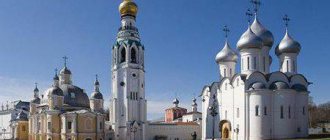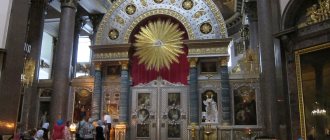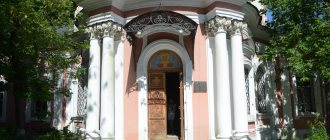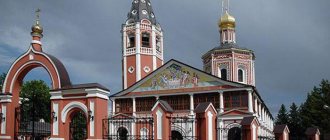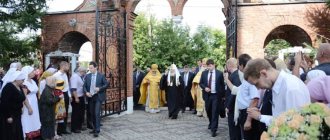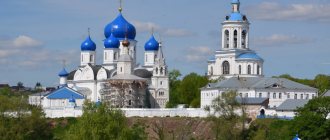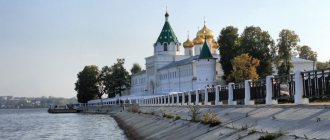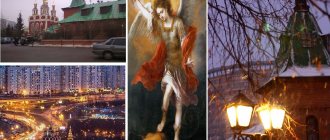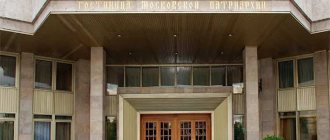Recently I had the opportunity to visit the ancient city of Vladimir on official business. There was time for sightseeing, and we were offered to visit the main religious attraction of the city - the Holy Assumption Cathedral in Vladimir on Klyazma, a brief description of which I would like to give below. I will share my impressions about this temple, its attractions, history and shrines. I’ll also tell you how best to get there, where you can stay and what the schedule of services is at the Holy Dormition Cathedral of Vladimir.
Where can you stay nearby?
If you are planning an independent visit, and not together with an organized tourist group, it is better to take care of accommodation in advance. There are good hotels in the city, but the rooms in them are usually booked by excursion companies. But if you have already come to visit the Holy Dormition Cathedral and decide to stay overnight, among the budget options nearby, you can consider the Zastava hotel and the WAU hostel . Of the more expensive ones the Orion Hotel , the Monomakh Hotel and the Rus Hotel .
Architectural features
Bogolyubsky Temple
The first church building (1158-1160) was erected from high quality white limestone. From the outside it looked very elegant and harmonious due to its correct and consistent proportions. Both outside and inside, there was an upward direction in everything, which gave a feeling of lightness and soaring. The vault at its highest point was 32.3 m.
3 naves inside the temple were separated by 6 pillars. 3 apses made up the altar part. The square of the dome with sides of 6.4 m is an elongated quadrangle, but visually it seemed that the building had a cubic shape. The length without apses is 22.5 m, the width is 17.5, the height of the vaults is about 21 m. Thin walls and cross-shaped pillars to match them gave the building elegance and lightness.
The pillars were decorated with pilasters (columns), which were crowned with leaf-shaped capitals. The arches supporting the vault connected to the “drum” of the large dome with tromps - a stepped structure that made it possible to transfer and distribute the load on the arches. This approach was not typical of the architecture of ancient Rus' and was used for the first time.
The dome drum had 12 elongated vertical windows. Each nave of the building had 3 porches (entrances). Large stones and cobblestones served as the foundation, loosely piled underneath. Only the last 2 rows, on which rubble was laid, were strengthened, and walls were erected on them.
The walls are decorated with an arcature belt consisting of columns, some of which are preserved on the northern wall of the temple. A decorative belt of columns crowns the curb. The upper base of the columns (capital) is cube-shaped, the columns are based on wedge-shaped consoles. The space between the columns is painted on the plastered surface.
The facades were decorated with pilasters with capitals in the Corinthian style, that is, bell-shaped.
The horizontal division of the facade with a decorative arched frieze was an additional decoration of the solid walls. There is a version that the walls of the original cathedral are from 1158-1160. were decorated with relief figures that have not survived. Decorative sculptures were of a zooanthropomorphic type - an ornamental carved belt with figures of fantastic creatures and animals.
The zakomaras (the semicircle of the junction of the roof and the wall) along the central façade were decorated with reliefs based on the biblical story about Babylonian youths, Christian warriors and Alexander the Great with griffins. Masks of lions and women decorated the window openings.
The picturesque painting, surviving in fragments, is located between the pilasters of the arcature-decorative belt on the northern side of the gallery - figures of prophets and peacocks. It is possible that they were the exterior paintings of the cathedral.
Temple of Vsevolod
The construction of the “Vsevolodov Galleries” around the old building of Prince Andrey began quickly. The new Cathedral turned out to be more majestic and larger. The facades of Vsevolod's galleries are decorated with vertical pilasters, the upper part of which ends with zakomaras.
The low arrangement of the galleries (the completion of the walls with a semicircle or wedge) created steps and attractiveness for the new building. The apses were lengthened. A decorative belt of arches with 114 columns divides the facades into two horizontal parts. Narrow, slit-like windows are located on the lower level, and wide ones with bevels are located on the upper tier.
The walls of the galleries are made of white limestone, but are inferior in quality to the white stone limestone of the Bogolyubovsky temple of 1158-1161. Some external walls were decorated with relief decoration. Some of them were moved from the walls of the old cathedral.
The Assumption Cathedral in Vladimir, the construction of which was entrusted by Vsevolod III to local builders, had a tendency towards the Byzantine style of architecture. The Bogolyubov Church was built by architects sent by Frederick Barbarossa, who partly applied the Venetian style of construction.
The history of the creation of the Holy Assumption Cathedral in Vladimir
- The history of the creation of the temple goes back to the 10th century , when under Grand Duke Vladimir the wooden Assumption Church was built on this site.
- In 1158, under Prince Andrei Bogolyubsky, a stone cathedral was founded. Its construction lasted three years, and already in 1161 it was consecrated.
- The cathedral stood for a little over twenty years, when a strong fire in 1185 destroyed or severely damaged most of the buildings in Vladimir. The temple was restored and somewhat expanded at the direction of Prince Vsevolod the Big Nest and in 1189 .
- In 1238, during the invasion of Batu’s troops, the last defenders of the city, along with the princely family and clergy, locked themselves in the cathedral. The Mongols set fire to the temple, and everyone in it died, although the building itself was not seriously damaged.
- The next stage of the cathedral's heyday dates back to the period of the late XIV - early XV centuries . Then, Prince Vasily, the son of Dmitry Donskoy, brought in Andrei Rublev and Daniil Cherny . Some fragments of their frescoes, in particular the “Last Judgment,” have survived to this day.
- At the border of the 16th – 17th centuries, the cathedral fell into disrepair, and only at the end of the 18th century , by order of Empress Catherine II, who visited Vladimir, they began to restore it. Over the next centuries, the cathedral was repeatedly updated and rebuilt. The last significant restoration work on the building was carried out in the 80s of the last century.
Patronal holidays[edit]
Dormition of the Blessed Virgin Mary
- August 28
Thrones:
- Panteleimon, healer, great martyr
- August 9
- blgv. Andrei Bogolyubsky (northern)
- blgv. Gleb Vladimirsky (southern)
- Georgievsky (at the junction of the northern façade of the cathedral with the bell tower)
- Miracle of the Archangel Michael in Khoneh (in the bell tower)
Holy Assumption Cathedral in Vladimir in the photo
Exterior view of the Holy Assumption Cathedral in Vladimir.
Inside the Assumption Cathedral in Vladimir, the famous frescoes are clearly visible in the photo.
Iconostasis of the Assumption Cathedral in Vladimir.
Current state of the cathedral
Today, the cross-domed five-domed temple combines two construction stages in its appearance: the ancient three-nave core and two-tier galleries equal in area, forming two additional naves.
Figure 2. At the altar
Architecture and decoration of the cathedral
The volumetric-spatial solution of the shrine is a quadrangle with choirs that have a mosquito cover. They end with helmet-shaped chapters. The semicircular apses are on the same level with the quadrangle, the internal space of which is filled with sixteen pillars.
The facades are divided into sections by half-columns; each section of the wall also has a side-by-side end. Slit-shaped windows and moderate decoration of the two-tier facade with reliefs only emphasize the beauty of the white stone. It was also used for the foundation, which was based on several rows of cobblestones. In the architecture of the cathedral one can see a combination of classical elements (paired columns of the bell tower) and pseudo-Gothic (pointed arches). The general style of the temple is called Russian Romanesque.
What's inside
The cathedral amazes with its splendor. The chapel is decorated with sculptures of people and animals. The path to the choir of the temple lies through the staircase tower, which adjoins the western porch. The walls are smooth, but their laconicism is diluted by reliefs from the sanctuary of Andrei Bogolyubsky. On the southwestern side you can see the figures of two saints - Artemy and Abraham. They are located on the iconostasis pillars.
Inside, literally everything delights: the abundance of gold and silver, mosaic floors, wooden doors with decorative elements, ornate baroque style.
Iconostasis
This architectural structure impresses with its grandiose dimensions - its height is more than 20 meters. Having a pyramidal structure, the iconostasis is made in three tiers: local, deesis and festive. It includes 123 icons painted on linden boards with oil paints. Each is a work of art. The Deesis tier is represented by fifteen three-meter-high icons, separated by profiled belts (horizontally) and columns with pilasters (vertically).
The completion of the iconostasis is a high relief image of Hosts with eight sculptures of angels, which crown the composition from different sides. The image of the “Annunciation” with carved royal doors is also of artistic value. The carving in the form of flower garlands, acanthus leaves, grapes and pomegranate fruits is very voluminous, which creates a play of light, complemented by reflections of gold.
Figure 3. Internal splendor of the cathedral
Shrines, relics
Almost 90% of the wall paintings were made in the 19th century, but as a result of restoration, fragments of a composition belonging to Andrei Rublev were discovered and restored. This is the Last Judgment of 1408.
Important. The temple for a long time remained the place of storage of the Vladimir Icon of the Mother of God, brought by Andrei Bogolyubsky from Vyshgorod for the opening of the shrine. The icon of the hand of the Evangelist Luke, in which the Mother of God is depicted at a meal with Joseph the Betrothed and her son Jesus, was in the cathedral until 1395. Today it can be seen in the temple at the Tretyakov Gallery.
The holy relics of Andrei Bogolyubsky are kept in a separate shrine, and in the necropolis of the Assumption Cathedral you can also find the dried remains of other great princes - the younger brother of Vsevolod, Yuri Vsevolodovich, Gleb of Murom and others. Here are the burials of more than 40 representatives of the princely and bishopric classes. For these purposes, special niches are equipped in the gallery. Among the buried was Metropolitan Maxim, known for having transferred the see to Vladimir from Kyiv. This happened in 1299.
Assumption Cathedral from above
Having visited the Holy Dormition Cathedral of Vladimir and other churches in Russia, you experience a strong impression. On the one hand, you seem to come into contact with history, with some generations of the creators of the temple and its parishioners. You experience all their life milestones with them. On the other hand, what is amazing is the grandeur of the structure, and how thoughtful all the artistic details are, down to the smallest detail. And, of course, frescoes. It is worth visiting this temple just to look at them.
What impressions did you have from the visit, please express your thoughts in the comments.
The Church of the Dormition of the Virgin Mary is a striking example of a Posad church
Most researchers agree that the Church of the Assumption of the Virgin Mary belongs to the most significant monuments of Vladimir architecture of the 17th century. A skyward building with five onion-shaped domes rises majestically above the river. Klyazma and stands out against the background of urban development. The temple is extremely elegant and beautiful, its decor is made in the spirit of Moscow and Yaroslavl churches of the same time. The cube of the main volume is completed with a lush wreath of keel-shaped and circular kokoshniks. The covered gallery (gulbishche) adjacent to the church and three porches protruding forward on faceted pillars create a picturesque three-dimensional composition. A tent-roofed bell tower is attached to the temple from the west. The original interiors of the Assumption Church have been lost, but the “skinny candles” stored in the Vladimir Museum give an idea of their patterning. These are hollow wax cylinders standing on high white stone pedestals. Colored patterns are hot applied to the surface of the cylinder, striking in the beauty and richness of the colors. Along the top of the “skinny candle” there is an inscription in Slavic script that immortalizes the names of “living room and industrial people”, the creators of the temple.
Attraction rating:
Rating 3.67 [3 vote(s)]
| ← VLADIMIR | VLADIMIR REGION | RUSSIA → |
Temple under Andrei Bogolyubsky
The Assumption Cathedral was not inferior in size to the Kyiv Sophia, its height was 32.3 meters (the height of the St. Sophia Cathedral is 29 meters) and up to 2000 people could be in it at the same time.
It was a five-domed temple built of white limestone. For the first time in Russian architecture, lion and female masks, as well as relief compositions, were depicted on its facades:
- Three youths in the fiery furnace
- Forty Martyrs of Sebaste
- Ascension of Alexander the Great to heaven.
The central chapter was covered with “red gold”, and in the entire external appearance and in the internal design there was a sense of upward direction.
Andrei Bogolyubsky donated huge land holdings and a tenth of the prince's income to the main temple of Vladimir-Suzdal Rus'.
Parishioners entered the temple through portals, the doors of which were decorated with gold. The floor resembled a sparkling carpet made of copper and colored majolica slabs.
The interior also shone with gold trim, majolica and painting. The parishioners experienced a feeling of joy, triumph and excitement during the service - the precious utensils of the temple reflected the shine of the candles, and above their heads, in the choir, stood the prince and his entourage.
Necropolis
The large cathedral in all cities and countries is the burial place of famous people, saints, saints and martyrs. More than 40 members of the princely family, canonized as saints and revered by the church and people, found their final refuge in the Assumption Cathedral.
In the galleries of the cathedral, from 1193, family members of the princely family began to be buried in arcosolium niches. A place of honor at the altar, in the northern gallery, was allocated for the repose of the founders and builders - Andrei Bogolyubsky and Vsevolod III. The bishops of the Vladimir diocese rest in the necropolis.
The ancient necropolis preserves the ashes of the blessed Grand Duchess Agafia Vsevolodovna, who died during the siege of the Tatar-Mongol troops in 1238. Hieromartyr Mitrofan, who died with Princess Agafia, rests here. In 1645, the relics of Grand Duke George Vsevolodovich were discovered incorrupt.
Further history
In 1810, a slender four-tier bell tower with a high gilded spire was built next to the cathedral. In 1862, according to the design of the Vladimir architect Nikolai Artleben, the St. George's chapel was built between the bell tower and the Assumption Cathedral, passing from the north to the lower tier of the bell tower.
In 1888–1891, a scientific restoration of the Assumption Cathedral was carried out, returning it to its original appearance. In many places, wall cladding was replaced, and reliefs lost on the facades were restored.
Interesting Facts
Historical facts say that the temple had a very difficult fate and long development. Several fires, Tatar-Mongol raids, robberies could not destroy the true art of ancient Russian architecture.
Spiritual foundations, the reverent attitude of generations towards the cathedral as a religious relic, the deep and true faith of people helped it become more beautiful and better:
- in 1410, the temple was again attacked by the Tatar-Mongols, who plundered and set fire to it. The bells burned out. The housekeeper Patrick hid part of the precious church utensils, for which he was tortured by his enemies. Whether he gave away his hiding place or not, nothing is said about this in the chronicles. It may happen that the lost jewelry will be found and take its place in the cathedral, as a memory of the centuries-old history and feat of Patricius;
- frescoes with prophets and peacocks, found inside the Vsevolod Gallery on the north side, say that the temple of Andrei Bogolyubsky had painted outer walls. It is easy to imagine the splendor and flowering along the walls of the snow-white building;
- restoration 1888-1891 recreated the appearance of the Cathedral of Vsevolod III, which has survived in this form to the present day;
- The Assumption Cathedrals in Moscow and Vladimir are similar, but they are distinguished by many architectural details;
- “zero kilometer” in Vladimir is counted from the bell tower of the Assumption Cathedral;
- Russian emperors and tsars always visited the cathedral before ascending the royal throne.
Ticket prices in 2022
During museum opening hours, entrance to the Assumption Cathedral is paid and amounts to:
- For adults - 150 rubles
- For children under 16 years old - free
- For children over 16 years old and students - 100 rubles
- Photography in the temple is prohibited!
If your visit falls during museum opening hours, we strongly recommend purchasing tickets with guided tours. They are only a little more expensive, but visiting this unique attraction of Vladimir, which contains, for example, frescoes of the famous Andrei Rublev, will become much more interesting.
